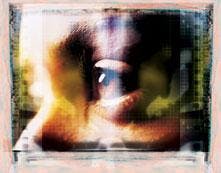Frightening memories, Frightening behavior
by Elizabeth Sciarratta, RDH
You trudge back to your room and throw the chart on the counter. Your back aches, and your stomach is in knots. Mrs. Jones once again managed to ruin your day. She was late, she had to go to the bathroom, and she gagged and jumped every time you went near her gumline. When she wasn't sitting up to spit, she was telling you which teeth to avoid.
Patients like this are frustrating. I used to get frazzled when people were late, jumpy, and otherwise uncooperative. One day I had a revelation that helped to change my view.
The hygienist working in the next operatory was treating a woman who was the victim of a violent assault. My co-worker did her best to be kind and comforting. As she leaned over the patient to begin treatment, the woman became hysterical and the appointment had to be terminated.
My co-worker had never touched the patient. What I suddenly realized was that it wasn't the hygienist the patient was reacting to. It was the image of somebody looming over her.
The light bulb in my brain went on. My patients are not reacting to me; they are reacting to previous experiences!
Post Traumatic Stress Disorder (PTSD) is a psychological condition in people who have experienced a traumatic situation. It is a cluster of behaviors that occur together. It can be mild to severe. Diagnosis of PTSD involves three components:
• Re-experiencing trauma — The person experiences the initial situation as if it were happening at that moment, even if it was years before. These experiences can range from a fleeting picture in the mind to a condition that lasts for hours.
• Avoidance — The person goes to great lengths to avoid re-experiencing the initial trauma or anything that reminds them of the initial trauma.
• Hypervigilance — The person is acutely aware of his or her surroundings, and constantly surveys the scene for reminders. This makes them irritable, easily startled, and jumpy. This can also produce physical symptoms such as chest pain or shortness of breath.1
If we apply these components to the dental setting, it's easy to see why many patients react the way they do.
Patients will go to great lengths to avoid this, so many avoid the dentist altogether. It is usually severe pain that brings them to the office, and this makes the visit even more frightening.
While in the dental office, they display symptoms of hypervigilance — nervous, jumpy, watching every move. They are easily startled, such as when the chair is moved or you touch them unexpectedly.
Therefore, a frightened patient may actually be experiencing PTSD, and their behavior is a result of their condition. Once you understand this, you can deal with it.
Fear and patient behavior
Patient behavior that is annoying to the dental professional is often based in fear, or an attempt to disguise that fear. Anger is a common mask for fear. A patient feels more powerful when he or she is angry rather than afraid. This is particularly true of men. Hostile patients can be rude, sullen, or outright cranky. I have had patients threaten physical harm or retribution if I "hurt them."
Fearful patients complain frequently. Sarcasm and jokes, particularly off color jokes, are cover-ups for fear.
Chronic lateness and breaking appointments are also based in fear. Avoidance is a symptom of PTSD. The easiest way to avoid an appointment is not to go.
Bathroom trips, spitting, rinsing, and gagging are all based in fear. These help the patient control the appointment. There may be legitimate physical reasons for these behaviors, but, more often than not, fear makes the symptoms worse.
Coping with annoying behavior
When I personalize, I interpret something as an affront or insult to me. Personalizing others' behavior creates stress when dealing with fearful patients. I was taking my patients' behavior personally and reacting defensively. It took me a long time to figure out it was my reaction to the patient that was the problem.
When I changed my attitude, things changed for me. I promised myself that I would try to make each patient's visit with me a positive experience.
Through trial and error, I have learned many techniques for reducing fear. The most important thing I've learned is that it isn't about me. I now accept people as they are and work from there.
Acknowledging and validating patients' fears goes a long way toward reducing them. This doesn't require a detailed analysis, just a reassurance that they are okay. Many fearful patients feel alone. When we tell them they are not the only ones, they feel better.
I have found that just a few minutes of conversation before a procedure works wonders. I talk to the patient about their situation. I reassure them that I am experienced and trustworthy. I smile and keep eye contact.
I ask frequently how the patient is doing. I tell them they are great and that I am proud of them. I use a gentle fulcrum and gentle touch, and try to support the jaw instead of pressing on it.
Mostly, I try to let them know that it's OK to be afraid. I remind them not to hold their breath or hyperventilate. I use humor when it's appropriate.
Most fearful patients feel ashamed of their feelings and their oral hygiene. I try never to add to anybody's shame. I keep my instructions honest but positive. I make helpful suggestions that patients can incorporate into their lifestyles. I can't change a person who doesn't want to change. When a patient is difficult, I breathe deeply. The more they fight me, the more I relax and try to feel love. It isn't always easy, and I am not perfect.
I truly enjoy the art and science of dental hygiene. I have found time and again that it benefits me as much as my patients to treat them with love.
Elizabeth Sciarratta, RDH, is a dental hygienist who has practiced for more than 15 years in Rochester, N.Y., and Colorado. She currently lives in Rochester with her husband and daughter. She earned a bachelor's in English with a minor in theater arts before returning to school to study dental hygiene. She is also a fiction writer who gets many of her character ideas from her patients.
References1 PTSD fact sheet available at www.Sidran.org/ptsdfacts.html

